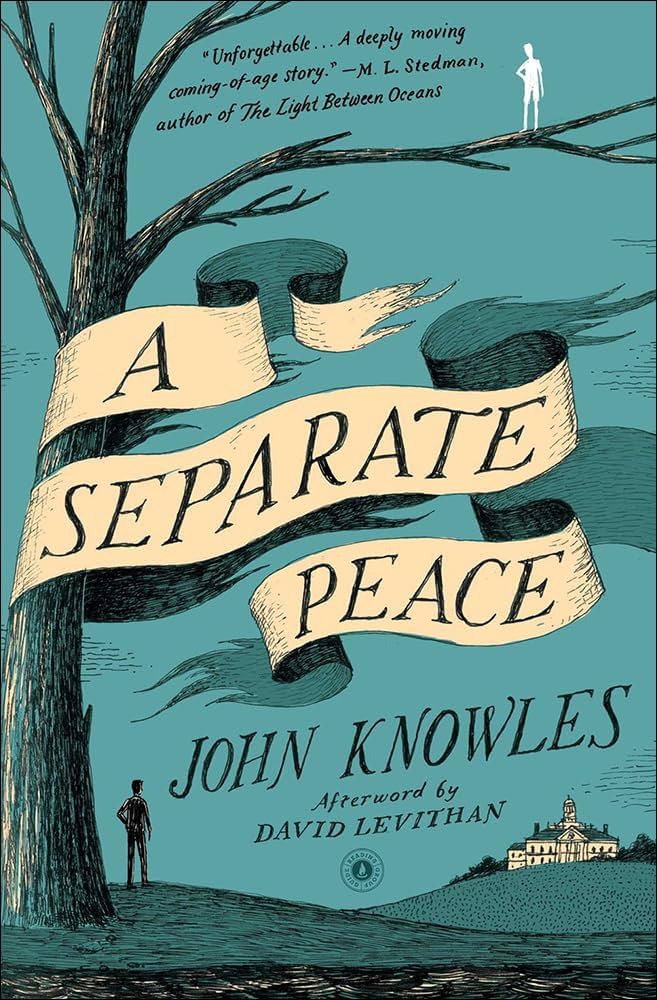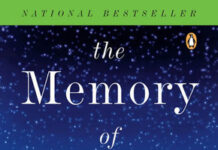In the quiet halls and sprawling grounds of Devon School, John Knowles weaves a poignant tale that delves beneath the surface of adolescent camaraderie and rivalry. A Separate Peace invites readers into a world shaped by the complexities of friendship, jealousy, and the shadows of internal conflict.This novel does not merely recount youthful experiences; it explores the delicate balance between innocence and the inevitable loss that accompanies growing up. As we turn the pages, we are compelled to reflect on the intimate struggles that define human relationships and the ways in which personal battles can echo far beyond their original setting. this review seeks to unravel how Knowles brilliantly captures these themes, offering a timeless meditation on the ties that bind-and sometimes unravel-our closest connections.
Understanding the Complex Dynamics of Friendship in A Separate Peace and Its Impact on character Development
The evolution of their friendship not only drives the narrative but also acts as a catalyst for conversion. It highlights key themes such as:
- Identity and self-perception - where personal doubts are mirrored in social interactions.
- The fragility of trust – exploring how misunderstandings can fracture even the closest bonds.
- Coming-of-age challenges – depicting the clash between innocence and harsh realities.
Their relationship serves as a microcosm of adolescence itself: full of contradictions,intense emotions,and the inexorable push towards maturity.
| Character | Key Emotion | Impact on Development |
|---|---|---|
| Gene | Jealousy & Self-Doubt | Catalyst for introspection and acceptance |
| Phineas | Confidence & innocence | Embodies the idealism that challenges reality |
Analyzing the Portrayal of Rivalry and jealousy as Central Themes Driving the Novel’s Dramatic Tension
In A Separate Peace, the intricacies of rivalry and jealousy act as the undercurrents that fuel the tension between the characters, particularly gene and Finny.Gene’s envy of Finny’s effortless charm and athletic prowess gradually morphs into a silent conflict, underscoring the fragile nature of their friendship. This emotional turmoil is not just personal but emblematic of the broader existential conflicts faced by adolescents navigating identity and belonging. The novel deftly captures how unspoken resentments and insecurities ferment beneath the surface, transforming seemingly innocent interactions into charged moments of psychological drama.
To further illustrate the dynamics of rivalry and jealousy, consider the following manifestations within the narrative:
- Competitiveness: Gene’s internal struggle with outperforming Finny, which amplifies his feelings of inadequacy.
- Manipulation: Instances where Gene’s jealousy subtly influences his actions, clouding his judgment.
- Denial and Projection: How both characters deflect their true feelings to maintain social equilibrium, yet inadvertently escalate the conflict.
| Theme | Representation | Impact on Plot |
|---|---|---|
| Rivalry | Gene vs.Finny in sports and academics | Triggers the critical accident |
| Jealousy | Gene’s envy of Finny’s social ease | Fuels internal guilt and denial |
| Friendship | Shared experiences despite tension | Complicates resolution and forgiveness |
The Role of Setting in Shaping Relationships and Reflecting Internal Conflicts Among the Characters
in A Separate Peace, the setting is more than just a backdrop; it acts as a silent architect molding the intricate relationships between Gene and Finny. The Devon School, with its sprawling lawns, quiet river, and ominous marble stairs, mirrors the duality of their friendship-peaceful yet perilous.The secluded nature of the school creates a microcosm where external societal pressures fade, intensifying internal emotions and conflicts. Within this contained surroundings, small actions and tensions assume outsized meaning, pushing Gene’s insecurities and envy to the forefront. the physical spaces-especially the tree from which Finny takes his daring leaps-embody the fragile balance of trust and rivalry that defines their connection.
key settings influencing dynamics:
- The Tree: a symbol of innocence and risk, where pivotal moments of trust and betrayal unfold.
- The Marble Stairs: representing both achievement and danger, they parallel Gene’s ascent into self-awareness through pain.
- The River: fluid and unpredictable, reflecting the constant undercurrent of change in their friendship.
This subtle but powerful use of setting allows the narrative to explore not only outward conflicts but also the characters’ inner turmoil. These landscapes act almost like mirrors, reflecting Gene’s guilt and Finny’s denial. The contrasts between open spaces and confined classrooms echo the tension between freedom and control, highlighting how external environments shape internal battles.Such interplay suggests that the physical world is intrinsically linked to emotional states, offering readers a richer understanding of friendship elaborate by competition, loyalty, and fear of loss.
| Setting | Symbolism | Emotional impact |
|---|---|---|
| The Tree | Innocence & Risk | Triggers trust and trauma |
| Marble Stairs | Achievement & Danger | Represents downfall & awakening |
| The River | Change & Flow | reflects internal unrest |
Exploring Identity and Self-Discovery Through the Lens of Adolescent Struggles in the Narrative
The dynamic between the main characters exemplifies how adolescent struggles crystallize identity through interpersonal tension. Themes such as jealousy, guilt, and the desire for approval clash with the innate human need for connection. This tension is evidenced by:
- Internal contradictions – conflicting feelings towards friendship and rivalry coexist.
- search for validation – acceptance is both sought and feared.
- Evolving self-awareness – moments of insight punctuate confusion.
These elements weave a narrative rich in emotional depth, visually represented in the table below, which outlines the characters’ shifting emotional states at crucial plot points.
| character | Emotional State | Moment in Narrative |
|---|---|---|
| Gene | conflicted jealousy, guilt | Post-fall introspection |
| Finny | Innocence, denial | After the initial accident |
| Leper | Isolation, fear | During military enlistment |
How John Knowles Uses Symbolism to Deepen the Reader’s Insight Into Conflict and Resolution
John Knowles masterfully employs symbolism throughout A Separate Peace to peel back layers of human psychology, illustrating the complex interplay between friendship and inner turmoil. The iconic “tree,” for example, transcends its physical presence as a mere landmark, embodying the pivotal moment of loss and betrayal that irrevocably reshapes Gene and Finny’s relationship. This natural symbol becomes a silent witness to pain, growth, and the fragile boundary between innocence and experience. Additionally, the bitter “war” serves as more than the backdrop; it reflects the personal battles raging within the characters, blurring the line between external chaos and internal conflict, enhancing readers’ understanding of how global strife mirrors intimate struggles.
By weaving these symbols into the narrative, Knowles invites readers to explore themes that might or else remain abstract. Consider the multifaceted roles of key symbolic elements:
- the Tree: A testament to youthful risk, loss, and sudden change.
- The Ice Sculpture: Represents Finny’s fragile identity and the elusive nature of perfection.
- The Geneva Swim Suit: A subtle marker of innocence intertwined with societal expectations.
| Symbol | Meaning | Impact on Conflict |
|---|---|---|
| The Tree | Turning point; loss of innocence | Triggers internal and external struggle |
| The War | Reflection of internal chaos | Amplifies personal conflicts |
| The Ice Sculpture | Fragility of identity | Highlights vulnerability in resolutions |
The Psychological Underpinnings of Guilt and Forgiveness in the Relationship Between Gene and Finny
Within the complex fabric of Gene and Finny’s friendship, guilt emerges as a profound emotional axis that dictates their interactions long after the pivotal accident. Gene’s internal turmoil is not merely a result of remorse but also a reflection of his intense self-awareness and shifting identity. His guilt is compounded by the intricate mixture of envy and admiration he feels towards Finny,creating an emotional paradox that challenges his sense of morality. This emotional weight creates a silent chasm between them,where forgiveness becomes both an elusive balm and a necessary step toward reconciliation.
Forgiveness, in this relationship, transcends the simple act of absolution; it functions as a transformative process that allows both boys to rebuild their fractured connection. It is through forgiveness that Gene begins to confront his insecurities and accept the vulnerability that his guilt has masked. The dynamic between them showcases how:
- Guilt can be a catalyst for self-analysis and growth,.
- Forgiveness involves acknowledging flaws without diminishing personal duty,
- The interplay of these emotions is essential in moving forward from trauma.
| Emotion | Impact on Gene | Impact on Finny |
|---|---|---|
| Guilt | Self-reproach, alienation | Unawareness, trust |
| Forgiveness | Growth, acceptance | Healing, reassurance |
A Close Look at Narrative Style and Perspective in Evoking Emotional Authenticity and Reader Engagement
John Knowles masterfully employs a first-person narrative through Gene’s reflective voice, creating an intimate window into his psyche. This perspective not only pulls readers closer to the unfolding emotional turmoil but also blurs the line between memory and present experience, enhancing the authenticity of his inner conflicts. The subtle shifts between Gene’s admiration, envy, and guilt allow readers to experience his fluctuations in real time, generating a profound empathy. By constraining the view solely to Gene’s point of view, Knowles invites readers to navigate the complexities of friendship and rivalry without external commentary, fostering a sense of closeness and suspense that elevates engagement.
- Limited perspective: creates suspense and reveals character flaws
- Reflective tone: layers past emotions with present understanding
- Symbolic imagery: deepens emotional resonance, e.g., the tree as a metaphor
The narrative style seamlessly entwines with the novel’s emotional landscape, presenting moments charged with tension and vulnerability. This is accentuated by Knowles’ use of subtle, almost conversational narration that feels both raw and controlled-a delicate balance that mirrors the frailty of adolescent relationships beset by the pressures of impending adulthood and wartime anxiety.The interplay of Gene’s unreliable narration and the evocative settings work together to heighten the reader’s emotional response, turning the novel into a vivid tapestry of friendship’s joys and conflicts.
| technique | Effect on Emotional Authenticity | Reader Engagement |
|---|---|---|
| First-person limited | Deep personal insight; subjective truth | Creates mystery and suspense |
| Flashbacks | Layered emotional impact | Encourages active interpretation |
| symbolism | Amplifies themes subtly | Invites deeper analysis |
The Influence of Historical Context on the Characters’ Interpersonal Conflicts and Decisions
Set against the backdrop of world War II, A Separate Peace subtly weaves its narrative with the anxiety and uncertainty that defined an entire generation. The shadow of war intensifies the boys’ inner turmoil, making their struggles far more than mere adolescent quarrels. For Gene and Finny, the external tension reflects an internal battlefield where jealousy, loyalty, and identity clash.Their decisions are deeply influenced by a world teetering on chaos-each confrontation and alliance mirroring the larger conflicts that haunt their minds. This historical context enriches the narrative, adding layers of significance to their interpersonal dynamics that might otherwise seem isolated or purely psychological.
The characters’ responses to the looming war highlight several key pressures:
- Loss of innocence: The ever-present threat of global conflict forces accelerated maturity,prompting choices steeped in fear and survival instinct.
- Escapism versus reality: The boys frequently oscillate between their insular world and the inevitable external demands, which complicates their friendships.
- Competition and identity: In a time when heroic ideals were glorified, the characters struggle to define themselves under immense societal expectations.
| Historical Element | Character Impact | Illustrative Conflict |
|---|---|---|
| World War II threat | Heightened anxiety and rivalry | Gene’s envy leading to Finny’s fall |
| Patriotic duty | Pressure to conform and enlist | Finny’s denial of war’s reality |
| Cultural expectations | Struggles with identity and courage | Gene’s internal moral conflict |
Critical Reception and Lasting impact of A Separate Peace in modern Literary Studies
John Knowles’ A Separate Peace continues to occupy a prominent place in modern literary discourse, admired for its intricate portrayal of adolescent psychology amidst the looming backdrop of war. Critics have lauded the novel’s exploration of the dualities of human nature – loyalty and envy, innocence and experience – as pivotal to understanding the complexity of friendship. Notably, the narrative’s subtle dissection of internal conflict has invited varied interpretations, revealing layers that resonate differently across generations.This critical engagement is reflected in diverse scholarly approaches:
- Psychological Analysis: Examination of gene’s internal struggles and the impact of suppressed emotions on identity formation.
- Historical Contextualization: Positioning the narrative within World War II’s influence on youth and societal expectations.
- Symbolic Readings: Deconstruction of the Devon School setting as a microcosm for broader moral conflicts.
- Pedagogical Discussions: Use of the novel in curricula to provoke dialog on ethical ambiguity and coming-of-age challenges.
Moreover, its lasting impact is visible in how educators and scholars consistently revisit the novel to illuminate tensions between camaraderie and rivalry. A Separate peace often serves as a mirror reflecting contemporary anxieties about identity and belonging, transcending its historical moment. The following table highlights key thematic elements that continue to captivate modern readers and their significance in literary studies:
| Theme | Modern Relevance | Critical Focus |
|---|---|---|
| Friendship & Rivalry | Explores complex human relationships beyond surface loyalty | Interpersonal dynamics and psychological depth |
| Loss of Innocence | Worldwide coming-of-age challenges in turbulent times | Symbolism and character transformation |
| War and Internal Conflict | Reflects societal pressures and personal turmoil | Historical and ethical interpretations |
Recommendations for Readers Interested in Themes of Friendship, Rivalry, and Moral Ambiguity
For readers captivated by the delicate interplay of friendship and rivalry, John Knowles’ narrative offers a profound meditation on how connections can both uplift and unravel. Delving into the complexities of adolescent relationships with an unflinching eye, it reveals the shadows lurking beneath seemingly pure bonds.if your literary appetite leans toward stories that challenge the simplistic notions of loyalty and envy, consider exploring these timeless works that echo similar themes:
- “The Catcher in the Rye” by J.D.Salinger: A raw portrayal of teenage alienation and conflicted friendships.
- “Lord of the Flies” by William Golding: An intense study of group dynamics, power struggles, and moral uncertainty.
- “east of Eden” by John Steinbeck: A layered exploration of sibling rivalry and ethical ambiguity across generations.
- “Never Let Me Go” by Kazuo Ishiguro: Friendship intertwined with haunting questions of identity and fate.
Understanding the multifaceted nature of characters who walk the line between heroism and flaw requires more than casual reading-it demands emotional engagement.The table below highlights key narrative elements from A Separate Peace alongside comparable motifs in other literary works, offering a compact guide to these themes in action:
| Theme | A Separate Peace | Comparable Work |
|---|---|---|
| Friendship | Intense, fragile, transformative | The Catcher in the Rye |
| Rivalry | Subtle, internalized, driving | East of Eden |
| Moral ambiguity | Persistent, haunting, unresolved | Lord of the Flies |
John Knowles as a Storyteller: His Life, Inspirations, and Contribution to 20th Century American Literature
Beyond just the coming-of-age story, Knowles made a lasting contribution to 20th-century American literature by emphasizing themes of identity, morality, and the loss of innocence. His narrative style is straightforward yet poetic,allowing readers to immerse themselves in the emotional intensity without distraction. The novel’s layered tensions are enhanced by a tight storytelling structure that balances moments of calm reflection with sudden emotional upheavals,reflecting the chaotic nature of both youth and war. Knowles’ influence continues to inspire writers to explore the delicate balances within human relationships and the often-painful journey toward self-understanding.
- Real-life inspiration: Exeter Academy experiences
- Key themes: Friendship, identity, morality
- Literary contributions: Poetic realism in adolescent narrative
- Historical context: World War II as a metaphor for internal conflict
| Element | Significance in Knowles’ Work |
|---|---|
| friendship | Complex and multifaceted, central to character development |
| Conflict | Both external (war) and internal (jealousy, identity) |
| Setting | Elite prep school symbolizing innocence and societal pressure |
| Narrative Style | Minimalistic prose with deep emotional undercurrents |
A Separate Peace invites readers to navigate the intricate landscape where friendship and conflict entwine, revealing the fragile truths beneath youthful camaraderie and rivalry. John Knowles’ nuanced portrayal leaves us pondering not only the battles waged in wartime, but those quietly fought within the human heart.As we close the pages, we’re reminded that the journey through friendship is seldom simple-marked by both light and shadow, growth and loss-echoing long after the final chapter fades.









